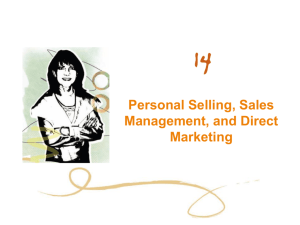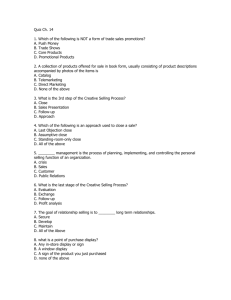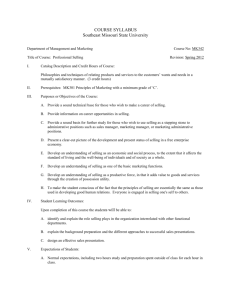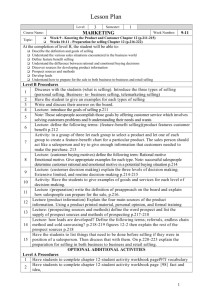To the Customer
advertisement
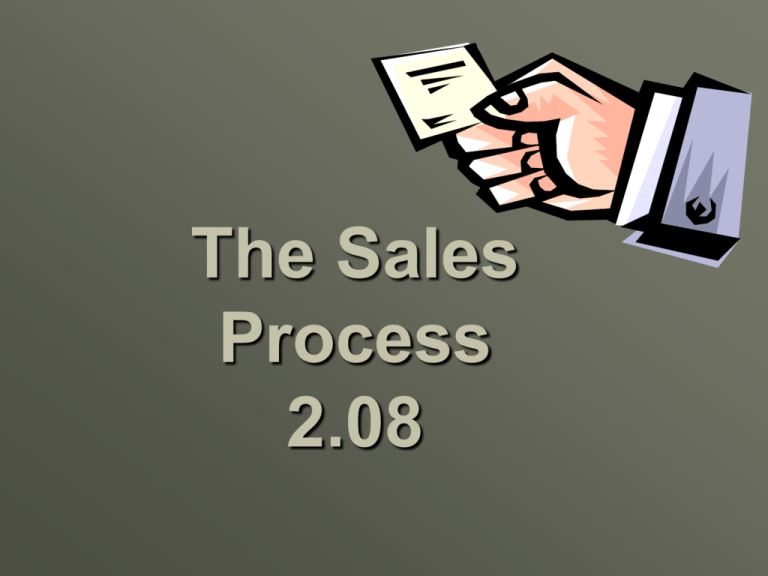
The Sales Process 2.08 Importance of Personal Selling Allows the firm to immediately respond to the needs of the prospect Allows for immediate customer feedback Results in an actual sale Evolution of Personal Selling Hard sell: Formerly thought customers had to be forced into making a purchase Relationship selling: Now selling requires the development of a trusting partnership in which the salesperson seeks to provide longterm customer satisfaction Recent Trends in Personal Selling Relationship selling: regular contacts over an extended period to establish a sustained sellerbuyer relationship Team selling: combination of salespeople with specialists from other functional areas to promote a product; useful in sales situations that call for detailed knowledge of new, complex, and ever-changing technologies Sales force automation (SFA): applications of computer and other technologies to make the sales function more efficient and competitive What is the main objective in sales? Supply needs & wants of customers Help customers make wise buying decisions To ensure customer satisfaction so the firm can count on repeat business Definition of Personal Selling Personal selling involves oral conversations, either by telephone or face-to-face, between salespersons and prospective customers. “A salesman is someone who sells goods that won’t come back, to customers who will.” (Anonymous) Personal Selling Personal Selling: Any form of direct contact between a salesperson and a customer. Types of personal selling situations • Retail Selling: Customers come to the store. • Business-to-Business Selling: May take place in a number of locations: manufacturer’s or wholesaler’s showroom (inside sales) or a customer’s place of business (outside sales). • Telemarketing: Selling over the telephone. Consultative Selling Consultative Selling: Providing solutions to customers’ problems by finding products to meet their needs. Feature - Benefit Selling The concept that a salesperson needs to match the features of each product to a customer’s needs and wants. • Product Features: A physical characteristic or quality of a good or service that explains what it is. Tangible Product Feature: Physical characteristics of a product. Extended Product Features: Although not always physically part of the product, important in the purchase decision. Feature - Benefit Selling (cont.) – Customer Benefits: Advantages or personal satisfaction a customer will get from a good or service. • • How does the feature help the product’s performance? How does the performance information give the customer a personal reason to buy the product? Selling Environments and Selling Types Selling Environments Selling Types Over-the-counter Order taker Order getter Professional salespeople National account managers Missionary salespeople Support salespeople Outbound Inbound Field Selling Telemarketing Over-the-Counter Selling Order taker Order Getter A salesperson who only processes the purchase that the customer has already selected Retail outlets that are heavily oriented toward self-service Over-the-Counter Selling Order taker Order Getter A salesperson who actively seeks to provide information to prospects, persuade prospective customers, and close sales Personal service oriented stores May practice suggestion selling Field Selling Professional Salespeople National account managers Missionary Salespeople Support Salespeople Help prospective customers to define their needs and then suggest the best means of meeting those needs, even if that requires suggesting that the prospects use a competitive product Field Selling Professional Salespeople National account managers Missionary Salespeople Support Salespeople Highly skilled salespersons who call on key customers’ headquarters sites, develop strategic plans for the accounts, make formal presentations to top-level executives, and assist with all the product decisions at that level Field Selling Professional Salespeople National account managers Missionary Salespeople Support Salespeople They do not seek to obtain a direct order from their customers Primary goal is to persuade customers to place orders with distributors or wholesalers Field Selling Professional Salespeople National account managers Missionary Salespeople Support Salespeople Support the sales force in a number of ways Technical support salespeople assist with technical aspects of sales presentations Merchandisers may set up product displays Telemarketing Telemarketing Utilizing the telephone for prospecting, selling, and/or following up with customers Outbound: the salesperson uses the telephone to call customers Inbound: Firms which have customers calling the vendor company to place orders (toll-free phone numbers) Integrating the Various Selling Channels THE FIVE SALES CHANNELS Over-theCounter Field Selling Inside Selling Telemarketing Online Selling Personal selling occurs through several types of communication channels Each sales channels has unique aspects which make it relevant for particular sales situations. Roles of Personal Selling a. b. c. d. e. f. Identifying decision makers, decision processes, and qualified buyers Promoting to corporate, travel trade, and other groups Generating increased sales at the point of purchase Providing detailed and up-to-date information to the travel trade Maintaining a personal relationship with key clients Gathering information on competitors’ promotions Why choose the sales profession? Employment in sales is growing Sales positions offer advantages: • • • • • • • Good compensation Intrinsic reward from helping customers Flexible in day-to-day activities High-visibility career track Limited supervision Travel opportunities Increasing responsibilities Specific Types of Sales Jobs Trade Selling Missionary Selling Technical Selling New-business Selling Retail Selling Telemarketing Build sales volume by providing customers with promotional assistance in the form of advertising and sales promotion Specific Types of Sales Jobs Trade Selling Missionary Selling Technical Selling New-business Selling Retail Selling Telemarketing Where trade salespeople sell to, missionary salespeople sell for its direct consumers Specific Types of Sales Jobs Trade Selling Missionary Selling Technical Selling New-business Selling Retail Selling Telemarketing Often technically trained in chemistry, engineering, and computer science Support the regular sales force or help sell the product Specific Types of Sales Jobs Trade Selling Missionary Selling Technical Selling New-business Selling Retail Selling Telemarketing Used in industries that have one time or very infrequent sales, thus, salespeople must constantly develop new leads to generate sales Specific Types of Sales Jobs Trade Selling Missionary Selling Technical Selling New-business Selling Retail Selling Telemarketing Wide range of skills required Can require knowledge, communication skills, and ability to work with diverse customers Specific Types of Sales Jobs Trade Selling Missionary Selling Technical Selling New-business Selling Retail Selling Telemarketing Telemarketing uses outbound calls to: • Open new accounts • Qualify advertising leads • Service existing business Annual Pay for Sales Representatives & Sales Managers Sales Force Compensation Commission: incentive compensation directly related to the sales or profits achieved by a salesperson Salary: fixed compensation payments made periodically to an employee What are the different kinds of customers? 1) Prospective Customer: no specific purchase in mind, undecided 2) Decided Customer: knows what they want, decided 3) Casual Visitor: no purchase in mind, may not be shopping, just looking 4) Customers with Complaints What are the four steps that most people go through when making a purchase? 1) Attention: thoughts are focused on a product 2) Interest: attractiveness or usefulness of the product has been noticed What are the four steps that most people go through when making a purchase? (cont.) 3) Desire: item is wanted by buyer 4) Action: customer makes decision Why do people to buy products? 1) To fulfill basic human needs 2) Wants: desirable but not essential What motivates people to buy a product or service? 3) Other factors: a. money or cost b. priorities c. self-confidence (a self confident customer is more likely to buy, and a self confident salesperson is more likely to sell) Customer Buying Decisions Rational Motive: Conscious, factual reason for a purchase such as: • product dependability • time or monetary savings • convenience • comfort • recreational value Customer Buying Decisions Emotional Motive: Feelings experienced by the customer such as: • • • • • • social approval recognition power love affection prestige Customer Buying Decisions Factors that affect customer decisions. • Amount of previous experience with the product. • How often the product is purchased. • Amount of information necessary to make a wise buying decision. Customer Buying Decisions (cont.) Factors that affect customer decisions. • Importance of the purchase to the customer. • Perceived risk involved in the purchase (financial loss, physical or emotional harm, won’t function properly). • Time available to make the decision. Customer Buying Decisions Extensive Decision Making: Used when there has been little or no previous experience with the item because it is infrequently purchased. Customer Buying Decisions Limited Decision Making: Used when a person buys goods and services that he or she has purchased before but not on a regular basis. Customer Buying Decisions Routine Decision Making: Used when a person needs little information about a product because of the high degree of prior experience with it. What are the methods used when dealing with different types of customers? 1) Talkative Customer: • Listen attentively and direct the conversation toward the product. • Be Patient. 2) Indecisive Customer: • Provide facts about the product patiently and thoroughly in order to reassure the customer What are the methods used when dealing with different types of customers? 3) Know-it-all Customer: • Let the customer confirm the facts. Do not compete or argue with the customer. 4) Silent Customer: • Ask intelligent questions in order to stimulate the conversation and always be patient. What are the methods used when dealing with different types of customers? 5) Disagreeable Customer: • Be patient, polite and do not show anger. Admit to any disadvantages of the product. 6) Delaying Customer: • List the sound reasons why product should be purchased. What are the methods used when dealing with different types of customers? 7) Decisive Customer: • Keep the sales presentation short and to the point. Allow the customer to state his/her conclusions. 8) Customer in a hurry: • Approach the customer immediately, determine their needs quickly and close the sale. How do you prevent a customer from being dissatisfied? The best way to handle a dissatisfied customer is to not create one. Make sure that any applicable warranty is thoroughly understood. Avoid selling a customer a product that does not fit their needs/wants. From the Customer’s Point of View The Customer Five Buying Decisions The Buying Process Product Place Price Time Quantity Attention Interest Desire Conviction Action From the Salesperson’s Point of View The Salesperson The Selling Process 1. 2. 3. 4. 5. 6. 7. 8. Preapproach Approach Determining Wants & Needs Feature-Benefit Presentation Overcoming Objections Closing the Sale Suggestion Selling Follow Up & Service The Sales Process • What happens during the process of a sale from the time you walk in the door to the time you leave? Steps of A Sale 1. Preapproach: Looking for customers and getting ready for the sale. 2. Approaching the customer: Actually greeting the customer face-to-face. 3. Determining needs/wants: Learning what a customer is looking for. Steps of A Sale 4. Presenting the product: Educating the customer about the product’s features and benefits. 5. Handling questions and objections: • Learning why the customer is reluctant to buy. • Providing information to remove that uncertainty. • Helping the customer make a satisfying buying decision. Steps of A Sale 6. Closing the sale: Getting the customer’s positive agreement to buy. 7. Suggestion selling: Suggesting that the customer buy additional merchandise or services. 8. Reassuring and following up: Helping a customer feel that he or she has made a wise purchase. The Sales Process – __________ Stage 1 APPROACH: 1. Preapproach 2. Approach 3. Determine Customer Wants & Needs Stage 2 PRESENTATION: (Select Product) 4. Feature Benefit Presentation 5. Handle Objections Stage 3 CLOSE: 6. Close the Sale 7. Suggestion Selling (Complete the transaction) 8. Follow Up & Service Throughout the sales process, the salesperson should be continually… • planning next action steps • confirming understanding • asking for referrals • seeking additional opportunities to serve & sell • evaluating responses & results (positive/ negative) • affirming decisions (minimizing buyer’s remorse) • positively expectant STEP #1: PREAPPROACH Getting ready for the sale…. Resources: Direct experience Written publications Other people Formal training The Pre Approach Observing and getting ready to sell • A customer walks into your store and you observe what they are looking at before you greet them. •You’re a home improvement business and you drive around the neighborhood to observe which houses require home repairs. 3 Types of Customers Decided The Preapproach Getting Ready to Sell Finding new customers by prospecting Retail sales not a prevalent because the customers come into the store. Important for the salesperson to open new accounts to generate sales volume. Prospect Find customers Get leads Build a referral base Cold-call Reasons for Prospecting 1. Increase Sales 1. Replace Customers Finding Customers Prospecting – looking for new customers… In order to be a Prospect: 1. Need for the product 2. Resources to buy product 3. Authority to buy What is prospecting? Finding potential customers Examples of Prospecting Wedding Pictures: • Look in newspapers for wedding announcements Roof Repair: • Door to Door/Drive by/Telemarketing Golf Vacations: • Mailing list for Golf Digest • Memberships to Courses Prospecting and qualifying prospective customers: Blind prospecting Cold calling or canvassing Sales blitz Lead prospecting Terms to Know Referrals • Potential customer names given by previous customers Cold Calls • Randomly searching for customers. Drive by Telemarketing The Personal Selling Process Prospecting Prospecting involves finding qualified sales leads Qualified sales leads: potential customers that have a need for the salesperson’s product, and are able to buy Referrals: obtained by the salesperson asking current customers if they know of someone else who might have a need for the salesperson’s product Cold-calling: means contacting prospective customers without a prior arrangement Sources and Methods of Prospecting Employer leads Telephone Directories Trade and Professional Directories Newspapers Commercial Lists Cold Canvassing Customer lists Buyer lists Orphaned customers Public Exhibition Observation Direct Mail Customer Referrals Interview Qualify prospect • Potential customer? Yes/No • How much will they buy? • Do you want them as a customer? Find out • • • • • What prospect needs Prospect’s problems Current suppliers (prices?) Attitudes, values Policies, decision makers Preparing for the Sale Industrial Sales Analyze past sales records. View notes about the personal aspects of the customer. Qualify new customers. Inquire with other salespeople who are with non-competing lines. Preparing for the Sale Industrial Sales Ask questions in a pre-visit phone call. Make an appointment to see the prospect in order to have time to explain the features of your product. The Personal Selling Process Pre-approach The collection of information about the potential customer and the customer’s company prior to the initial visit Researching the prospect and the company will assist the salesperson in planning the initial presentation to the prospective customer Preparing for the Sale Retail Sales The customer comes to you, so most of the preparation is in the retail store. Stock keeping and house keeping duties are important. Learn about the merchandise and the prices of the merchandise. STEP #2: APPROACH The 1st communication between salesperson and customer The APPROACH is… The first face-to-face contact with the customer. Can make or break a sale Sets the mood or atmosphere Establishes a relationship What your mother said is true . . . You never get a second chance to make a first impression! Approaching the Customer First impressions count; if a customer is turned off by the approach it will be difficult to win him or her over. Be alert to what interests the customer. Approach (cont.) Establish a rapport and a positive relationship with the customer. Be aware of the customer’s buying style The Approach in Industrial Sales Setup an appointment during the preapproach, and arrive early to the appointment. Introduce yourself, smile, and shake hands. The Approach in Industrial Sales Engage in small talk to build a relationship with the customer. Comment on important things to keep the customer interested. The Approach in Business-to-Business Selling ♦ ♦ ♦ ♦ Set up an appointment Introduce yourself with a firm handshake and a smile. Be more personal with customers you know. Use good opening statements with new customers. The Approach in Retail Selling If customer is in a hurry, approach quickly. If customer is undecided, let them look. Encourage customers to look around and to ask questions. The first encounter with a potential customer… •Service approach •Greeting approach •Merchandise approach •Combination approach Methods for the initial approach: Service Approach Method Ask if assistance is needed. “May I help you?” Problem – customer says, “I’m just looking.” Instead, ask “How may I help you?” The Approach in Retail Sales Service Approach Method “How may I help you” Appropriate when the customer is obviously in a hurry or you are simply an order taker. Ineffective in most situations; you lose control of the sales situation. Greeting Approach Method •The salesperson welcomes the customer •“Good morning.” •Establishes a positive atmosphere. The Approach in Retail Sales Greeting Approach Method “Good afternoon, Mr. Wright” or an appropriate personal comment. This approach begins conversation and establishes a positive rapport. Do not focus on the merchandise. Merchandise Approach Method •Let the customer look around. When they show interest in a product, the salesperson makes a comment or asks a question. •The most effective approach because it gets the customer talking about the merchandise he/she may be interested in. The Approach in Retail Sales Merchandise Approach Method The salesperson makes a comment or asks questions about a product that the customer is looking at. Ask questions about the item. Usually the most effective approach because it immediately focuses attention on the merchandise. Which Approaches ? SERVICE APPROACH DECIDED CUSTOMER The decided customer doesn’t require your help. They know what they want. They are ready to buy. Timing: You must move quickly. The decided customer will take possession (hold) of the product. The decided customer may be headed toward the check out. Which Approaches ? MERCHANDISE APPROACH UNDECIDED CUSTOMER The undecided customer will require your patience. They will have many questions, and will require product information. Never give this customer too many choices, they will have a hard time making a decision. Timing: Allow them to look first then approach Which Approaches ? MERCHANDISE APPROACH JUST LOOKING CUSTOMER The just looking customer will require your patience. They like to be left alone. Timing: Allow them to look – Go slow. REVIEW Types of Approaches 1) Service HOW may I help you? 2) Greeting Hi welcome to Wal-Mart REVIEW Types of Approaches 3) Merchandise I noticed you were looking at our latest in pottery. 4) Combination Hello, we have a special today buy 2 shirts get the 3rd one ½ off! STEP #3: DETERMINE CUSTOMER WANTS & NEEDS How to determine consumer needs: Determine customer’s reasons for buying Observing Listening Questioning and Engaging The Personal Selling Process Need Identification Requires asking probing questions of the prospective customer to determine needs The salesperson should ask open-ended questions Make sure that the customer’s needs and potential concerns are addressed When to Determine Needs In Retail Selling: Immediately after the approach. In Industrial Selling: During the preapproach. Analyze Needs Usually during initial/only meeting in business to consumer (retail) sales. Detailed analysis of customer needs. How will customer use product? How will it help customer? Throughout the sales process, the salesperson should be continually… • • • • • • • • • asking questions listening qualifying (the opportunity for both parties) discovering hot buttons (wiifm?-what’s in it for me?) building rapport establishing trust developing credibility developing a valuable relationship addressing objections How to Determine Needs Observing Listening Questioning What methods are used to determine customer wants and needs? 1) 2) Ask direct questions and give clear answers Observe what merchandise the customer looks at What methods are used to determine customer wants & needs? (cont.) 3) Watch the customers facial expressions for clues or reactions to the sales presentation 4) Listen carefully to what the customer says STEP #4: PRODUCT PRESENTATION What products do you show? • How they will use the product? • Show a medium-priced product first! • Highlight the features and benefits (FEATURE BENEFIT PRESENTATION) The Personal Selling Process Presentation The focus of the sales presentation is the salesperson’s explanation of how the features of the product provide “benefits” Presentation may be flexible or memorized The salesperson should be prepared to provide documentation for any statements of fact that are made Select Products to Present Decide which products to show. Determine the price range. Show no more than 3 products at a time. What to Do Display the product creatively and attractively. Demonstrate to build customer confidence. Use sales aids such as articles, audio-visual aids, drawings, graphs, etc… Keep the customer involved. What methods are used to fulfill customer wants and needs? 1) 1) 2) Point out product benefits that best fit the customer needs Explain facts in terms the customer can understand Demonstrate product to customer Product Presentation This is the pitch. Show how your product helps solve customer’s problems. Match your product’s features (attributes) to customer’s needs and problems. Focus on customer. This is a skill that needs to be learned. Product presentation time! Display and handle the product Demonstrate the product Use sales aids Involve the customer Hold the customer’s attention REMEMBER Customers BUY BENEFITS! STEP #5: OVERCOMING OBJECTIONS Objection vs. Excuse Objection based on: -Need -Product -Source -Price -Time The Personal Selling Process Handling Objections The salesperson may have failed to provide adequate information, or have not demonstrated how the product meets the needs of the prospect Objection is a sign of interest on the part of the prospect Provide information that will ensure the prospect’s confidence in making the purchase Objection or Excuse? Objections - Honest reasons a customer has for not making a purchase. Excuses - Insincere reasons for not making a purchase. Common Objections Need: Customer has a conflict between wanting something and truly needing it. Product: Objections based on the product itself such as quality, size, appearance, or style. Source: Objections based on negative past experiences with the firm or brand. Price: More common with high-quality, expensive merchandise. Time: Usually reveal a hesitation to buy immediately. Sometimes are in the form of excuses. Handling Objections Listen Carefully. Acknowledge the Customer’s Objections. Restate the Objections. Answer the Objection. Methods to handle objections Substitution Boomerang Question Superior-point Denial Demonstration Third party STEP #6: CLOSING THE SALE Watch for buying signals: Verbal closing clues Non-verbal closing clues The Personal Selling Process Gaining Commitment Commitment is gained when the prospect agrees to take the action sought by the salesperson The salesperson must ask for commitment Close This is where you make your money. This is why salespeople exist! The most important part of the salesperson’s job. Lots of tricks and techniques… be careful. Be persistent. 5x average (no vs. yes) ABC - Always be Closing Be prepared to close the sale at any time. The sales process doesn't have to continue through all the steps. You can close a sale at any time. Prospect who is ready to buy, money in hand, waving it in the air, however, the salesperson stops them and says wait, I haven't finished my presentation yet, let me tell you how great I am. They've been taught to go through all the steps so they keep talking and many times talk themselves out of a sale. At any point during the sales process the prospect is ready to buy...close the sale. How to Recognize Buying Signs Buyers will often give you signs they want what you're selling. These signs can either be verbal or visual. A buyer may start asking more questions. They nod their head in agreement. They require more in depth information. They start talking about how things will be when they own the product. How to Recognize Buying Signs Some visual signs to watch for are: • • • • a smile, a raising of the eyebrows moving closer to you so they can see better. If it's a couple they may show more affection or they may look at each other in a certain way. When you have memorized your presentation you can be more aware of these buying signs and your closing ratio will increase dramatically. When you know what you are going to say and don't need to think about it, your sales will increase dramatically because you can sit back and watch their body language and buying signals and you'll know when they're ready to buy. Methods for closing the sale Which Standing-room only Direct Service CLOSING METHODS • Which Close: Encourages a customer to make a decision between two items. • Standing-Room-Only Close: Used when a product is in short supply or the price will go up in the near future. • Direct Close: Method in which you ask for the sale. • Service Close: Explains services that overcome obstacles or problems. How to Make the Decision to Close the Sale When you have qualified the prospect properly, the buying signs are there and you know they want to buy, make the decision that the best thing for the customer is to buy. Then focus your attention on talking about the things they like or feel are important as you close the sale. Put your personal feelings about your product or service aside and focus on the buyer. Seven More Possible Strategies for Closing Sales 1. 2. 3. 4. 5. 6. 7. Trial closes Assumptive close Summary or summary-of-the-benefits close Special concession close Eliminating-the-single-objection or final-concern close Limited-choice close Direct-appeal close Closing the Sale Failure to Close the Sale. • If at first you don’t succeed try again. • 60% of all sales follow four or more attempted closes. STEP #7: SUGGESTION SELLING Selling additional goods to enhance the original purchase Cross selling Upselling Special sales opportunities Suggestion Selling Benefits • To the Salesperson: Shows genuine concern for the customer and makes them want to do business with you again. • To the Customer: He or she is more pleased with the original purchase. • To the Company: The time and cost involved in suggestion selling is less than the cost of making the original sale. Suggestion Selling Methods • Offer Related Merchandise: A good or service the customer should have to increase the use or enjoyment of the original purchase. • Recommending Larger Quantities: This method usually works with inexpensive items or when money, time, and/or convenience will be saved. • Call Attention to Special Sales Opportunities: As a matter of customer service, salespeople are obligated to communicate special sales opportunities. STEP #8: FOLLOW UP & SERVICE It’s not over when the customer signs. Make sure delivery is made, customer is trained, and customer is happy. Periodically, check in with customer. Don’t just show up when it’s time to make another sale. If you don’t keep customer happy…. someone else will! (your competition) The Personal Selling Process Follow- Up The salesperson completes any agreed upon actions The salesperson should stay in touch after the sale by writing thank-you notes, clipping and mailing newspaper articles of interest to the prospect and calling on the customer to ensure the customer’s satisfaction How to maintain a relationship with the customer… Order processing Order fulfillment Customer service Keeping a client file Evaluate sales efforts Reassuring and Following-up After-Sale Activities • Customer Relationship Management (CRM): Involves strategies used to stay close to customers. • Taking Payment / Taking the Order: Work quickly and courteously to complete the order and avoid saying or doing anything that might irritate the customer. • Departure: Before the customer leaves, or before departing a clients office, reassure the person of the wise buying choices that have been made. • Follow-up: Follow through with all promises and check on customer satisfaction with the purchase. • Evaluation: Send questionnaires or call customers to check on how well they were treated by the sales and service staff. Remember everything you do builds the relationship you have with your customer… What is CRM? Customer Relationship Management Implement technology and CRM Maintain contacts Maintain relationships Develop customer loyalty Implement rewards program Customer Service Tips And Techniques Customer Relationship Management (CRM): Involves strategies used to stay close to customers. 68% of people quit doing business with companies that have poor customer service. It is far easier to lose customers due to poor service than for your product's quality or cost. It costs 5 times as much to bring in a new customer, than to keep an existing one. Customer Service Tips And Techniques Attention to customer service will go a long way in helping you to satisfy your customers and make them feel as if they are truly special. CRM 1. Always tell your customer what you CAN do for them. Don't begin your conversation by telling them what you CAN'T do. 2. Allow irate customers to vent. Do not interrupt them or start to speak until they have finished having their say. 3. Diffuse anger by saying "I'm sorry” or "I apologize." 4. Use your customer's name at different points in the conversation. CRM (cont.) 5. Make certain that your "solution" to the customer's problem is acceptable to them. Get their approval and agreement. 6. Always conclude each conversation with a "Thank you" or a verbal message of appreciation for their business. 7. Make certain that your tone of voice is in sync with your words. Remember, your tone of voice can completely contradict your message. CRM (cont.) 8. Listen attentively! There is nothing worse than asking an irate or troubled customer to REPEAT what they have just said. 9. Go the extra step by following up on your solution. Re-contact the customer to make certain that everything has been handled in a satisfactory manner, and they are pleased with the outcome. 10. Remember to ask if there is anything else that you can do for your customer. Taking the time to ask the question often results in increased business and a more committed customer.

